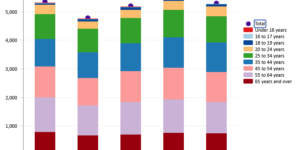There’s a two-out-of-three chance that the world will temporarily hit a key warming limit within the next five years, the United Nations weather agency said Wednesday.
But it likely would only be a fleeting and less worrisome flirtation with the internationally agreed upon temperature threshold. Scientists expect a temporary burst of heat from El Nino — a naturally-occurring weather phenomenon — to supercharge human-caused warming from the burning of coal, oil and gas to new heights. Temperatures are expected to then slip back down a bit.
The World Meteorological Organization forecasts a 66 percent likelihood that between now and 2027, the globe will have a year that averages 1.5 degrees Celsius (2.7 degrees Fahrenheit) warmer than the mid 19th century.
That number is critical because the 2015 Paris climate agreement set 1.5 degrees Celsius as a global guardrail in atmospheric warming, with countries pledging to try to prevent that much long-term warming if possible.
Scientists in a special 2018 United Nations report said going past that point would be drastically and dangerously different with more death, destruction and damage to global ecosystems.
“It won’t be this year probably. Maybe it’ll be next year or the year after” that a year averages 1.5 degrees Celsius, said report lead author Leon Hermanson, a climate scientist at the United Kingdom’s Met Office.
But climate scientists said what’s likely to happen in the next five years isn’t the same as failing the global goal.
“This report does not mean that we will permanently exceed the 1.5 C level specified in the Paris Agreement, which refers to long-term warming over many years. However, WMO is sounding the alarm that we will breach the 1.5 C level on a temporary basis with increasing frequency,” WMO Secretary-General Petteri Taalas said in a statement.
“We haven’t been able to limit the warming so far, and we are still moving in the wrong, wrong direction,” Taalas said at a Wednesday press conference.
Hermanson cautioned that ”a single year doesn’t really mean anything.” Scientists usually use 30-year averages.
Those 66 percent odds of a single year hitting that threshold in five years have increased from 48 percent last year, 40 percent the year before, 20 percent in 2020 and 10 percent about a decade ago. The WMO report is based on calculations by 11 different climate science centers across the globe.
The world has been inching closer to the 1.5-degree threshold due to human-caused climate change for years. The temporary warming of this year’s expected El Nino — which starts with a warming of parts of the central Pacific Ocean and then sloshes across the globe — makes it ”possible for us to see a single year exceeding 1.5 C a full decade before the long-term average,” said climate scientist Zeke Hausfather of the tech company Stripe and Berkeley Earth, who wasn’t part of the WMO report.
“We don’t expect the longer-term average to pass 1.5 C until the early-to-mid 2030s,” Hausfather said in an email.
But each year at or near 1.5 matters.
“We see this report as more of a barometer of how we’re getting close, because the closer you get to the threshold, the more noise bumping up and down is going to bump you over the threshold randomly,” Hermanson said in an interview. And he said the more random bumps over the mark occur, the closer the world actually gets to the threshold.
Key in all this is the El Nino cycle. The world is coming off a record-tying triple-dip La Nina — three straight years of El Nino’s cooler cousin restraining the human-caused warming climb — and is on the verge of an El Nino that some scientists predict will be strong.
The La Nina somewhat flattened the trend of human-caused warming so that the world hasn’t broken the annual temperature mark since 2016, during the last El Nino, a super-sized one, Hermanson said.
And that means a 98 percent chance of breaking the 2016 annual global temperature record between now and 2027, the report said. There’s also a 98 percent chance that the next five years will be the hottest five years on record, the report said.
Because of the shift from La Nina to El Nino “where there were floods before, there will be droughts and where there were droughts before there might be floods,” Hermanson said.
The report warned that the Amazon will be abnormally dry for a good part of the next five years while the Sahel part of Africa — the transition zone between the Sahara on the north and the savannas to the south — will be wetter.
That’s “one of the positive things coming out of this forecast,” Hermanson said. “It’s not all doom-and-gloom and heat waves.”
University of Pennsylvania climate scientist Michael Mann said reports like this put too much emphasis on global surface temperature, which varies with the El Nino cycle, even though it is climbing upward in the long term.
The real concern is the deep water of oceans, which absorb an overwhelming majority of the world’s human-caused warming, leading to a steady rise in ocean heat content and new records set regularly.
“I think it’s important to realize that if we pass 1.5 degrees it’s not a reason to give up,” Hermanson said at a Wednesday news conference. “We have to continue working out how much we can reduce emissions of greenhouse gases as much as possible, even after that, because it will make a difference.”





















 California Vocational School CEO Charged With 23 Counts of Insurance Fraud
California Vocational School CEO Charged With 23 Counts of Insurance Fraud  Carrier Management’s 2024 Top Features (Reader’s Picks Unlocked)
Carrier Management’s 2024 Top Features (Reader’s Picks Unlocked)  The War on Wildfires Is Going High-Tech
The War on Wildfires Is Going High-Tech  Surviving the ‘Silver Tsunami’: Closing the Talent, Skills Gap in Underwriting
Surviving the ‘Silver Tsunami’: Closing the Talent, Skills Gap in Underwriting 




